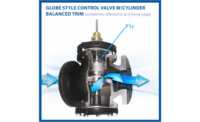Picking up where I left off in May, when I touched on designing sheet metal distribution, this month I am going to hit the high points of engineering a pipe distribution system with thoughts on closed systems, open systems, hot water heating, chilled water cooling, and condenser water pipe distribution.
To begin, the less experienced designer needs to read up on the definition of a closed water system versus an open water system. As a rule, hot water systems and chilled water cooling systems are closed (not open to the atmosphere). Condenser water systems often are open to the atmosphere at the cooling tower where warm condenser water returns to the tower and the water’s heat is given up to the atmosphere by spraying over the tower’s distribution baffles ending up in the tower’s sump tank.
Like duct distribution design, factors such as standardization, accessibility, and connection efficiency all serve important roles in a cost-effective installation, as well as operation and maintenance in the years to come. Piping design and construction installation has its own additional challenges/opportunities when the design engineer wants to share the piping distribution efficiencies with the person installing the pipe. After all, a proactive pipe fitter comes with years of specific fabrication and installation experience that the designer probably doesn’t have. Here are some tricks of the trade that I’ve learned by listening to the fitter. I’ve used these over the years when it comes to water piping distribution design.
- It takes about the same labor to install a .75-in pipe as it does to install a 1-in or 1.25-in pipe. The cost will be in the materials, so if there are a lot of pieces of equipment with several fittings and valves, etc., then consider standardizing on 1-in and 1.25-in piping and minimize the use of .75-in piping. Strive to make the installation as simple and as repetitive as possible.
- The more costly issue with water piping is whether the pipe will be a screwed, soldered, or a welded pipe installation. When I worked at an HVAC design-build firm, I left the selection of pipe material up to our construction project manager and our estimator to make the decision as to whether we used black iron screwed pipe or copper soldered pipe. Depending on the cost of copper at the time of the installation, I was simply interested in getting the water to flow throughout the system and return consuming the estimated pump energy. I found back then that some pipe fitters were quicker and could provide a cleaner installation with copper pipe versus screwed pipe and the oil used to create the screwed threads.
- As the design engineer, I had to consider changing from 2-in screwed pipe to 2.50-in welded pipe. I would strive to avoid making that decision of introducing welded pipe into the project if at all possible. Often with our design-build approach, and if the project was an infrastructure upgrade and/or renovation within an occupied building, I’d ask our piping foreman for his input. When the largest pipe was 4 in, the pipe fitters would routinely choose copper pipe over 2.50- through 4-in welded pipe to eliminate the welding. We’d save on site costs such as having a fire watch due to the welding and fire hazard process. Several times, we were able to allow the occupants to remain in their workspace while we worked around them because we didn’t have the hot sparks flying from the welder doing her job. It was true that the copper was going to cost more than black iron pipe, but we weighted the tradeoffs that included the owner’s workers not needing to be relocated during the construction. As a result of our integrated project delivery approach, I was satisfied that the design intent was met and we delivered the most cost-effective piping installation for the building owner while his work continued with limited disruption.
I will say that you probably won’t be able to implement these suggestions if the project delivery method is design-bid-build, because it is not a team effort, not knowing in advance the contractor. ES





